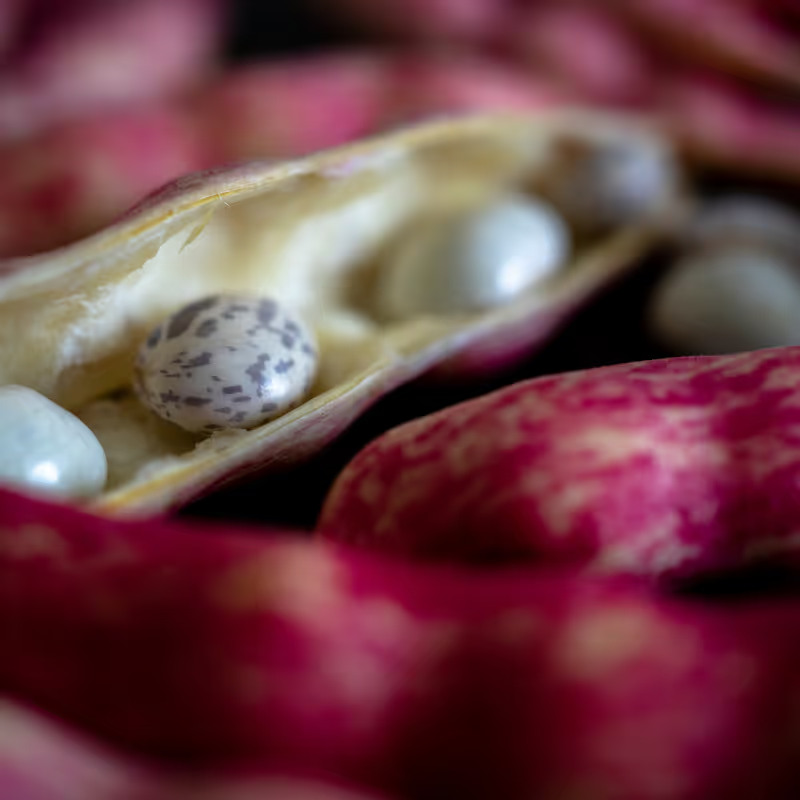What Does it Taste Like?
The flavor of fresh shells beans varies based on the variety. Their texture is creamy and tender, providing a pleasant contrast to crisp vegetables or hearty grains. Unlike dried beans, which need extensive soaking and cooking, fresh shell beans are quick to prepare and add a delightful freshness to your meals.
Varieties we grow

Aprovecho (Fava Beans)
Large and buttery, these heirloom favas have a rich, nutty sweetness that shines in purees, risottos, and springtime salads. Their creamy texture is best highlighted when blanched and peeled, then tossed with olive oil, lemon, and herbs. Fava beans have on outer coating that, when the beans are fully mature, becomes tough and difficult to eat. You can easily remove these skins by popping the shelled beans into boiling water for a few minutes to loosen the skin and then slide right off.
Why Should I Eat It?
Shell beans are rich in protein, fiber, and essential vitamins and minerals. They are an excellent source of folate, iron, and magnesium, which support overall health. Additionally, their high fiber content aids in digestion and helps maintain a healthy weight.
Shell Beans

Varies
Hidden beneath their humble pods, shell beans are nature's little treasures waiting to be discovered. Fresh and vibrant, they offer a world of culinary possibilities that extend far beyond their dried counterparts. Whether nestled in a summer salad or simmered in a comforting stew, these beans bring a delightful texture and flavor to any dish.
Recommended Storage
How Do I Store It?
Short Term
Store fresh, unshelled beans in their pods in the refrigerator. Place them in a perforated plastic bag or a container with a lid, leaving it slightly open to allow for air circulation. They should be used within a week for the best flavor and texture.
Long Term
- Freezing: Blanch shelled beans in boiling water for 2-3 minutes, then transfer them to an ice bath to stop the cooking process. Drain and pat dry, then spread them on a baking sheet to freeze individually before transferring to a freezer bag. They can be stored for up to 6 months.
- Pickling: Prepare a brine with vinegar, water, sugar, and spices. Blanch the beans for 2-3 minutes, then place them in sterilized jars and cover with the hot brine. Seal and store in the refrigerator for up to 3 months.
- Dehydrating: Blanch shelled beans for 2-3 minutes, then spread them on dehydrator trays. Dry at 125°F until completely dry and brittle. Store in airtight containers in a cool, dark place for up to a year. If you don't have a dehydrator, you can use your oven. Set it to the lowest temperature possible, typically around 140-150°F. Spread the blanched beans on a baking sheet in a single layer. Leave the oven door slightly ajar to allow moisture to escape. Dry the beans for 6-12 hours, checking them periodically to ensure they are drying evenly. They should be completely dry and brittle before storing.
How Do I Cook It?
- Boiling: After shelling the beans, rinse them under cold water. Bring a pot of water to a boil, add a pinch of salt, and cook the beans for 20-30 minutes until tender. Drain and use in salads or as a side dish.
- Steaming: Shell the beans and rinse. Place them in a steamer basket over boiling water. Cover and steam for 15-20 minutes until tender. Season with olive oil, lemon juice, and herbs for a simple side dish.
- Sautéing: Shell the beans and rinse. Heat olive oil in a skillet over medium heat. Add the beans and sauté for 10-15 minutes until tender, adding garlic and herbs in the last few minutes for extra flavor.
- Simmering in Broth: Shell the beans and rinse. In a saucepan, bring vegetable or chicken broth to a simmer. Add the beans and cook for 20-30 minutes until tender. This method infuses the beans with rich flavors, perfect for soups and stews.
Shelling Tip: To shell the beans, simply open the pods and remove the beans. Fresh shell beans do not need to be soaked before cooking.
